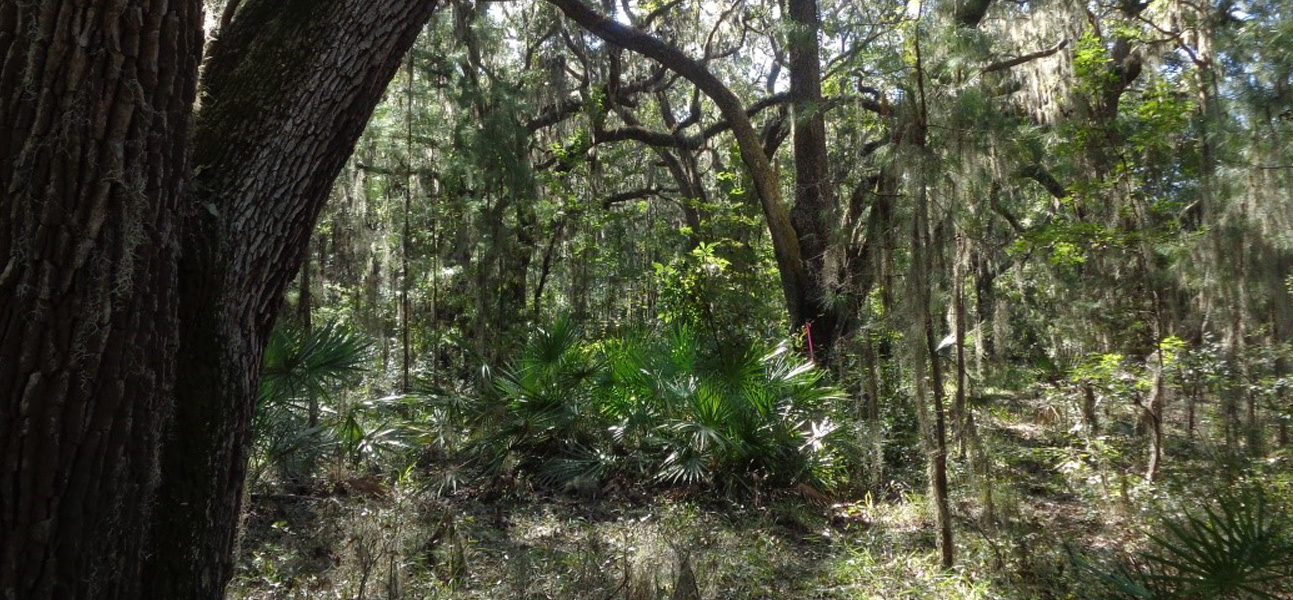
19 Apr Where the Wild Things are…or grow…in Georgia
Most archaeologists are drawn to the field by a desire for adventure and the thrill of discovery. Then we find out that our ‘adventures’ consist mostly of pastures, briars, and hundreds of empty holes! But that’s not always the case. Sometimes we get all the adventure that we can handle! We completed a project like that last year.
We were awarded the project in 2013, but it was 2016 before the work began. The survey work was for a commercial development on the coast of southeastern Georgia. The property had been converted from its industrial use to an expansive pine plantation and was covered by a mix of pines, saw palmetto, and dense secondary growth. The areas proposed for the development were in isolated segments to be connected by a series of roads, some existing and some new. The field work was conducted in two trips, one in August for three weeks, and another for two weeks in October. In all, 89.1 acres were surveyed, along with 5.2 miles of road right-of-way.
Due to the industrial history of the property, the safety standards for this project were far more stringent than what we normally encounter. We were required to tuck and tape our pants cuffs, wear snake gaiters, steel-toed boots, long-sleeved shirts, hardhats, and spoggles (yes, spoggles) every day. We had to decontaminate our shovels and screens after every shovel test using distilled water and paper towels, just in case we encountered contaminated soils. We were not allowed to have any contact with the soil with bare skin, so we were required to handle any artifacts with nitrile gloves. A portion of the project area was located within ranges where mortar rounds were test fired, so the threat of encountering unexploded ordnance (UXO) was very real. In these areas, we were accompanied by UXO technicians, who would sweep the spot prior to us digging the shovel test. After removing 30cm of soil, they would sweep it again and allow us to continue. Fortunately, no UXO was encountered.
The biggest obstacles that we faced were natural and not man-made. The ground cover in the areas where pines had been planted was incredible. Some areas were covered by a mat of palmetto and privet with vines intertwined throughout. Since the safety plan did not allow for us to use machetes, we literally had to crawl over these areas to where the hole needed to be, then burrow down through the vegetation to the ground! The native live oaks were still present in some areas, where the palmetto and Spanish moss gave it a primitive look. We encountered one swamp that was so large there was no way to go around it, which meant that we had to go through it. Fortunately, we were provided with two four-seat ATVs, which were just tall enough to get us through without taking on too much water.
And then there were the ticks and the snakes! We were warned about both by the caretakers of the property and were prepared. With our cuffs tucked and taped and our clothes sprayed with permethrin, we were fairly successful at keeping the ticks at bay. One day at lunch, I looked down at the ground while I was eating to see a lot of movement. I assumed it was ants, but on closer inspection, it was a large number of ticks! I walked through at least one nest of little, tiny, seed ticks, which covered one pocket of my cargo pants. Fortunately, I was able to scrape most of them off and the rest died of exposure to my toxic clothing!
Other than seeing a beautiful indigo snake, we only had one encounter with snakes. That was enough! There were three or four of us walking on a trail into the woods along one of the transects. I looked up in time to see a large rattlesnake coiled under a palmetto about 10 feet from us. He obviously knew that we were there, but thankfully uncoiled and moved away from us. He was about four feet long. While we were watching that one, his smaller buddy was making a run for it right across the trail! Jason looked down to see it crawling away from us right at our feet! We were too busy watching the bigger one to notice it at first. We stood there for quite a while watching where they were going and the trip back down the trail was much more cautious!
Not all the creatures that we encountered were quite so scary. Banana spiders are huge and unnerving, but aren’t dangerous. Their webs are built about head-high and may actually be made of piano wire. Gopher tortoises, which are a protected species, armadillos, and feral pigs were our constant companions. Deer sign was everywhere, but we actually saw very few.
The property has a long history. The area was settled by the Floyd family in 1800. By 1804, John Floyd had constructed two plantation houses, one for himself and one for his father, Charles. John’s house was named Fairview and was located just north of the project area. His father’s house was called Bellevue, and was located to the west of the project area. It was particularly interesting as it was made of tabby and was built in the shape of an anchor. The ruins of Bellevue are still standing. John moved to Bellevue following his father’s death in 1820, leaving Fairview to his son, Charles Rinaldo Floyd. Rinaldo became famous for his pursuit of the Seminole across the Okefenokee Swamp during the Seminole Wars. When he died in 1848, he was buried in the back yard of the house, where a marble obelisk now marks his grave. Several other members of the family are buried in the Floyd Family Cemetery beneath raised brick vaults. Both houses were burned during the Civil War. No construction is planned for the location of either house, so no archaeological work was conducted at either place.
In all, we dug 957 shovel tests, which produced 117 artifacts. We revisited two previously recorded sites, 9CM30 and 9CM64, and discovered two more sites, 9CM570 and 9CM571. Sites 9CM30 and 9CM64 were recorded during a pedestrian survey of the area in the late 1970s. All of the sites were prehistoric artifact scatters associated with shell middens that were at least partially intact. They were all located in the northeastern portion of the project area where the launch structure will be located. This area was covered by old growth live oaks interspersed with areas of dense saw palmetto. The prehistoric assemblage from the sites consisted almost exclusively of ceramics, with very few pieces of lithic debris and faunal remains. The ceramics included a variety of Woodland and Mississippian types common to the Georgia coast. One very unusual sherd was recovered from Site 9CM570. The sherd is sand/grit tempered and is partially painted with a very dark brown or black pigment. The temporal affiliation of this sherd is not known, as it does not match any known form described in the region. All four sites contained intact deposits and were recommended as potentially eligible for inclusion on the National Register.
As this project clearly demonstrated, archaeology isn’t easy. At times, it takes mental and physical toughness, and a willingness to endure some pretty harsh conditions in order to get the job done. But the thing that is absolutely required is teamwork. The team that we put together to do this project is what made its success possible and I’m going to take this space to brag on them a little. Jason Ross, Karen Taylor, Tommy McAlpine, and Justin Williams served as the field crew and did a great job handling all of the crazy requirements that were thrown at us and worked extremely hard. I can’t thank them enough for their effort!



